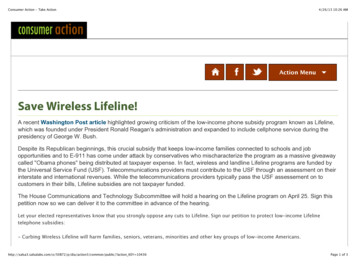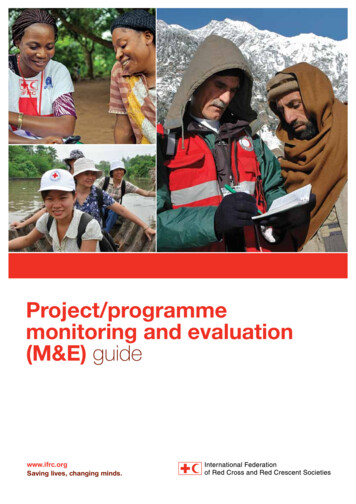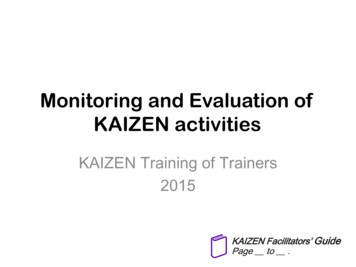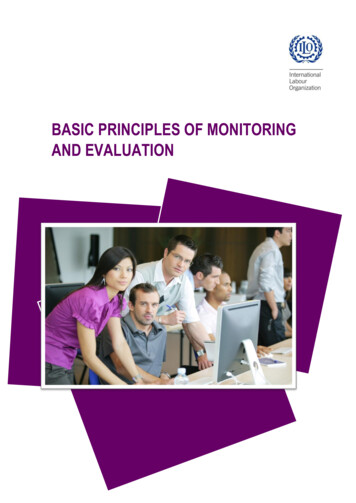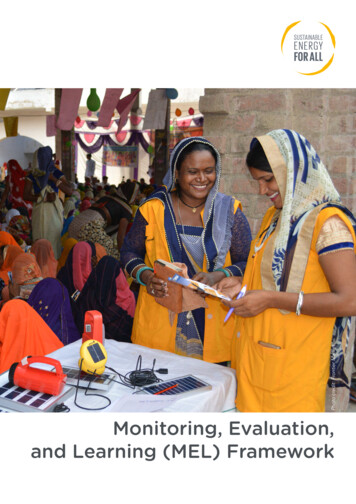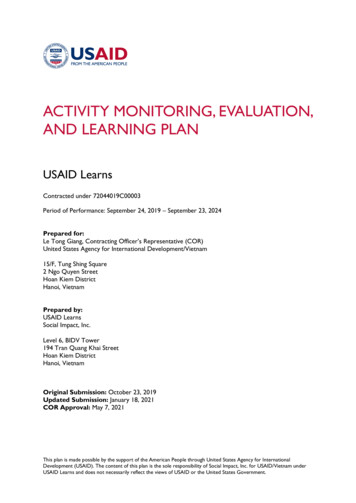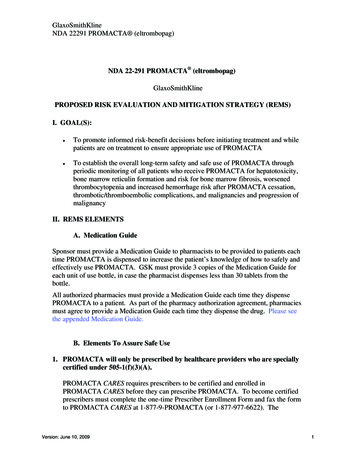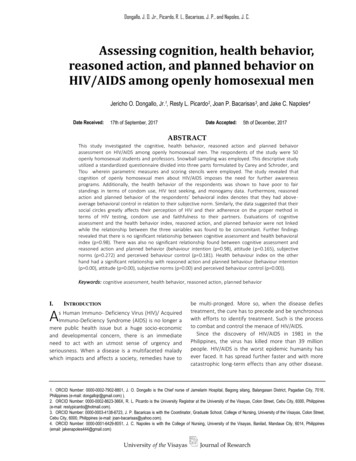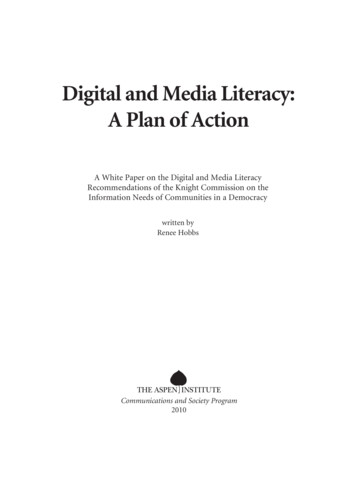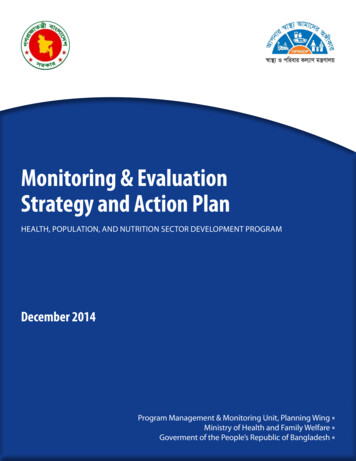
Transcription
lyJuly20112011- -JuneJune20162016JulyJuly20112011- -JuneJune2Monitoring & RT (APIR) 2013ANDACTIONACTIONPLANPLANANNUAL2013 PROGRAMREPORT (APIR)ANNUALPROGRAMIMPIMPHEALTH, POPULATION, AND NUTRITION SECTOR DEVELOPMENT r U)PLANNINGWINGPLANNING COFGOVERNMENT OF THE PEOPLE’S REPUBLICOFBANGLADESHBANGLADESHPROGRAMMANAGEMENT AND MONIPROGRAM MANAGEMENT AND berMINISTRY OF HEALTH PUGOVERNMENT OF THE PEOPLE’S rogram Management& MonitoringUnit, PlanningWing * OFHEALTHHEALTHANDANDFAMILYFAMILYWELFAREWELFARE Ministry of Health and Family Welfare *GovermentofBANGLADESHthePeople’s Republic of Bangladesh ��SREPUBLICREPUBLICOFBANGLADESHi
HEALTH, POPULATION AND NUTRITIONSECTOR DEVELOPMENT PROGRAM (HPNSDP)July 2011 - June 2016MONITORING & EVALUATION (M&E)STRATEGYAND ACTION PLANPROGRAM MANAGEMENT & MONITORING UNIT (PMMU)PLANNING WINGMINISTRY OF HEALTH AND FAMILY WELFAREGOVERNMENT OF THE PEOPLE’S REPUBLIC OF BANGLADESHDecember 2014i
i
TABLE OF CONTENTSPREFACE. IIIEXECUTIVE SUMMARY . 1CHAPTER 1. INTRODUCTION . 31.1PURPOSE OF M&E STRATEGY . 31.2GOAL AND OBJECTIVES OF THE M&E STRATEGY . 31.3PROCESS OF DEVELOPING M&E STRATEGY. 41.4ORGANIZATION OF THE REPORT . 5CHAPTER 2. M&E FRAMEWORK FOR HNP SECTOR PROGRAM . 62.1M&E FRAMEWORK FOR HPNSDP. 62.2M&E TOOLS FOR HPNSDP . 72.3SOURCES OF DATA FOR HPNSDP MONITORING . 102.4DISSEMINATION OF HPNSDP MONITORING DATA . 12CHAPTER 3. STRATEGY TO GUIDE M&E PROCESSES IN THE HNP SECTOR PROGRAM . 153.1STRATEGIC ISSUES AND ACTIONS FOR STRENGTHENING M&E IN HPNSDP . 153.2M&E REVIEW RESPONSIBILITIES AND ACTION BY LEVELS . 22CHAPTER 4. PLANS FOR IMPLEMENTATION OF STRATEGIC ACTIONS. 244.1AIM OF M&E ACTION PLAN FOR HNP SECTOR PROGRAM. 244.2KEY INTERVENTIONS UNDER M&E STRATEGY . 264.3CAPACITY BUILDING PLAN . 344.4DATA QUALITY PLAN . 354.5DATA UTILIZATION PLAN . 36ANNEXURES . 38ANNEX.1MOHFW NOTIFICATION ON M&E STRATEGY AND ACTION PLAN TWG . 39ANNEX.2DOCUMENTS CONSULTED . 41ANNEX.3INDICATIVE TIMETABLE FOR SURVEYS (FOR RFW UPDATE). 46ANNEX.4DATA QUALITY ASSESSMENT CHECKLIST AND TOOLS . 47ANNEX.5MOHFW NOTIFICATION ON PMMU. 50ANNEX.6ASSESSMENT OF EXISTING M&E MECHANISM OF HPNSDP . 52ANNEX.7M&E SYSTEMS IN PREVIOUS AND CURRENT HNP SECTOR PROGRAMS . 62ANNEX.8HNP SECTOR MONITORING OUTSIDE MOHFW . 65i
ii
PREFACEThe Health, Population and Nutrition Sector Development Program (HPNSDP) is beingimplemented in Bangladesh since July 2011 with the strategic objective of improving access toand utilization of essential health, population and nutrition services, particularly by the poor.Based on the lessons learned from the previous HNP sector programs, HPNSDP focused onsystems strengthening including monitoring and evaluation (M&E).This Strategy for Bangladesh’s HNP sector program, in particular to HPNSDP, has been preparedin response to recommendations from the 2012 and 2013 Annual Program Reviews (APRs) ofHPNSDP that the Ministry of Health and Family Welfare (MOHFW) will develop an M&EStrategy to ensure that key MISs are able to operate complimentarily. It is intended to provide astrategic framework for the MOHFW to strengthen and streamline the M&E processes withinstitutional responsibilities towards a harmonized information system for the HNP sector.The preparation and finalization of the M&E Strategy and Action Plan is a joint effort of theMESAP Technical Working Group, comprising different stakeholders and partners. Withouttheir sincere efforts, support and cooperation the review and finalization process could not havebeen possible on time. The Planning Wing also recognizes the role of the MIS and Planning Unitsof DGHS and DGFP as well as that of the members of the Program Management and MonitoringUnit (PMMU) in preparing this Strategy and Action Plan. The support provided by the PMMUTechnical Assistance Support Team (TAST) members (from MEASURE Evaluation and ICDDR,B)is duly appreciated.I hope that the Report would be found relevant and useful by the Government, the DevelopmentPartners and other stakeholders working in Bangladesh’s HNP sector. . .Niru Shamsun NaharJoint Chief (Planning)Ministry of Health and Family WelfareGovernment of the People’s Republic of Bangladeshiii
ABBREVIATIONS & ACRONYMSADPAIDSAPIRAPRBDHSAnnual Development ProgramAcquired Immunodeficiency SyndromeAnnual Program Implementation ReportAnnual Program ReviewBangladesh Demographic and HealthSurveyBHFS Bangladesh Health Facility SurveyBMMS Bangladesh Maternal Mortality SurveyCCCommunity ClinicCDCCommunicable Disease ControlCHCP Community Health Care ProviderCPRContraceptive Prevalence RateCSBA Community Skilled Birth AttendantDAAR Disbursement for Accelerated Achievementof ResultsDFID UK Department for InternationalDevelopmentDGHS Director General of Health ServicesDGFP Director General of Family PlanningECNEC Executive Committee of the NationalEconomic CouncilEmOC Emergency Obstetric CareEPIExpanded Program of ImmunizationFPFamily PlanningFWAFamily Welfare AssistantFWVFamily Welfare VisitorFYFiscal YearGOBGovernment of BangladeshHAHealth AssistantHEFHealth Economics and FinancingHEUHealth Economics UnitHIS & eH Health Information System and E-HealthHIVHuman Immunodeficiency VirusHNPHealth Nutrition and PopulationHNPSP Health Nutrition and Population SectorProgramHPSP Health and Population Sector ProgramICDDR,B International Centre for DiarrhoealDisease Research, BangladeshICTInformation and CommunicationTechnologyIEDCR Institute of Epidemiology and DiseaseControl ResearchIMCIIntegrated Management of ChildhoodIllnessesIMED Implementation Monitoring and EvaluationDivisionIRTIndependent Review TeamISTIn-Service TrainingITNInsecticide treated netsLCGLocal Consultative GroupLDLine DirectorLMIS Logistical Management Information SystemMCRAH Maternal Child and Reproductive HealthMCWC Maternal and Child Welfare CenterMDGMillennium Development GoalM&EMonitoring & EvaluationMISManagement Information SystemMMR Maternal Mortality RatioMNCAH Maternal Neonatal, Child and AdolescentHealthMOFMinistry of FinanceMOHFW Ministry of Health and Family WelfareMOPA Ministry of Public AdministrationMTBF Medium Term Budget FrameworkNASP National AIDS/STD ProgramNGONon-Governmental OrganizationNIPORT National Institute of Population Researchand TrainingNIPSOM National Institute of Preventive and SocialMedicineOPOperational PlanPADProject Appraisal DocumentPBFPerformance Based FinancingPERPublic Expenditure ReviewPIPProgram Implementation PlanPMEPlanning, Monitoring and EvaluationPMRPlanning, Monitoring and ResearchPWPlanning WingRFWResults FrameworkSACMO Sub-Assistant Community Medical OfficerSBASkilled Birth AttendantSWAp Sector Wide ApproachSWPMM Sector Wide Program Management andMonitoringTRDTraining, Research and DevelopmentUESD Utilization of Essential Service DeliveryUHCUpazila Health ComplexUH&FWC Union Health and Family Welfare CenterUHFPO Upazila Health & Family Planning OfficerUNUnited NationsUSAID United States Agency for InternationalDevelopmentWHO World Health Organizationiv
EXECUTIVE SUMMARYSimple, implementable monitoring and evaluation (M&E) plans that adhere to fieldpracticalities and a set of accepted best practices are crucial to continually improve programperformance. Particularly for sector-wide approaches in complex sector like health, nutritionand population (HNP), M&E processes can assist the public sector in evaluating its performanceand identifying the factors which contribute to its service delivery outcomes.From July 2011, the Ministry of Health and Family Welfare (MOHFW) has launched the Health,Population and Nutrition Sector Development Program (HPNSDP) for 2011-2016, whichemphasized on strengthening overall health system and governance by establishing asustainable M&E system as one of the key drivers. In response to recommendations from the2012 and 2013 Annual Program Reviews (APRs) of HPNSDP that the Ministry of Health andFamily Welfare (MOHFW) will develop an M&E Strategy to ensure that key MISs are able tooperate complimentarily, this M&E Strategy and Action Plan (MESAP) has been developed. Themain purposes of the MESAP are to (i) outline various roles and responsibilities regarding M&Ewith a view to tracking progress and demonstrating results, (ii) use it as a tool for monitoringprogress both in physical and financial terms and (iii) use it as a communication tool fordocumenting the M&E mechanisms. Specifically, MESAP will allow the MOHFW to effectivelyassess the program performance and initiative specific steps and tools for strengthening M&Esystems in the HNP sector. This elaborates an M&E framework for the ongoing HNP sectorprogram that comprises a range of indicators at various levels to measure, monitor and evaluateboth implementation and impact of HPNSDP – this framework is primarily based on the RFWapproach, with the idea that achieving specific results at different levels would lead to desiredhealth impact.The development of MESAP has largely been informed by lessons from the Annual ProgramReviews (APRs) of the current and the previous HNP sector programs in Bangladesh andassessments conducted by development partners (DPs) as well as technical agencies during thelast few years. The technical approach and methodology followed for development of theMESAP was highly consultative and participatory in nature – a Technical Working Group (TWG)was responsible for overseeing its development, and it was finalized through stakeholderconsultations involving MOHFW agencies, DPs, Civil Society, private sector and academiaworking in the HNP sector in Bangladesh.The key strategic pillars of MESAP to help accelerate MOHFW’s efforts in strengthening M&Esystem by addressing major limitations identified in Annex 6 are: 1) coordination andharmonization; 2) incentives for contribution to results; 3) standardized and streamlined datacollection and reporting; 4) capacity building; and 5) resource allocation for M&E activities.Based on an overall situational assessment of the existing M&E mechanism and practices, theMESAP formulated two action plans outlining transitional adjustments required during HPNSDPand medium- to long-term activities to have an effective and sustainable M&E systemsinstituted in Bangladesh’s HNP sector. In order to develop the activity package in the M&EAction Plan for HNP sector programs including HPNSDP, following key interventions wereidentified: a) strengthen M&E coordination within HNP sector program; b) carry out1
performance reviews at regular intervals; c) enforce Data Quality Assurance mechanisms; andd) build capacity for M&E among MOHFW staff.MESAP also includes a) Capacity Building Plan to facilitate and promote the development ofmonitoring and evaluation knowledge, skills and competence of MOHFW staff; b) Data QualityPlan to integrate periodic data quality assessment (DQA) using tools outlined in thePerformance Monitoring Plan (PMP) of HPNSDP into ongoing activities; and c) Data UtilizationPlan to ensure that generated data are being utilized for informed decision making within theMOHFW.The Program Management and Monitoring Unit (PMMU) in close collaboration with Planningand MIS Units of the Directorates will take lead in capacity building, data quality assessment,and data utilization processes under the overall supervision of the Planning Wing. It isenvisaged that timely implementation of action plan will help MOHFW and other stakeholdersto institutionalize M&E mechanisms for strengthening the use of information at both nationaland sub-national levels.2
CHAPTER 1. INTRODUCTIONThe need to invest in well-functioning national health sector monitoring and evaluation (M&E)systems is widely acknowledged (Holvoet & Inberg 2013) in the context of sector-wideapproaches (SWAp) and the considerable funding being put into the social sectors. An M&Esystem not only provides essential data for monitoring the services delivered, it also helps inguiding the planning, coordination, and implementation processes of a program and identifyingareas for development, and thus improving the system as a whole.Particularly for SWAps in complex sector like health, nutrition and population (HNP), theGovernment’s major challenge is to become more effective in allocating and using resources.M&E processes can assist the public sector in evaluating its performance and identifying thefactors which contribute to its service delivery outcomes. It provides an evidence base forresource allocation decisions and helps identify how challenges should be addressed andsuccesses replicated (IEG 2012).1.1PURPOSE OF M&E STRATEGYThe main purposes of the M&E Strategy for the ongoing Health, Population and Nutrition SectorDevelopment Program (HPNSDP) are to (i) outline various roles and responsibilities regardingM&E with a view to tracking progress and demonstrating results, (ii) use it as a tool formonitoring progress both in physical and financial terms and (iii) use it as a communication toolfor documenting the M&E mechanisms. Specifically, an M&E Strategy will allow the Ministry ofHealth and Family Welfare (MOHFW), its implementing agencies and Development Partners(DP) to:ooooo1.2assess more effectively how far the Program goals and objectives are being achieved;outline specific steps and tools for informed decision making;develop plans for data collection, analysis, use, and data quality;carry out oversight activities and program evaluation; andorganize various M&E activities that must take place for tracking progress towardsachieving results in a sustainable manner.GOAL AND OBJECTIVES OF THE M&E STRATEGYThe M&E Strategy is aligned with one of the key drivers for HPNSDP (GOB 2011a). This dulyacknowledges the necessity of developing a functional and robust M&E system for HPNSDP toprovide useful and timely information to policymakers and program managers. Thepolicymakers and managers track performance of the Program to ensure achievements ofresults through necessary course corrections during its implementation.1.2.1GoalThe goal is to establish a sustainable M&E system for tracking progress and demonstratingresults of the Program and to ensure evidence-based decision making.3
1.2.2Specific objectivesThe specific objectives of the M&E Strategy are to:1) Improve the quality and capacity of the routine data collection systems, e.g.,development of registries, routine data collection forms, type and frequency of reports,etc;2) Outline specific activities required for strengthening the organizational capacity toconduct effective M&E3) Ensure greater utilization of routine data sources; and4) Strengthen the monitoring culture within MOHFW and its Directorates by promoting theuse of locally generated health information.1.2.3Key outputsThe expected key outputs of the M&E Strategy are:1) Prepare an M&E Action Plan for short- and medium-term2) A functional robust, comprehensive, and well-coordinated M&E system for HPNSDP inplace;3) Regular updates on performance indicators available;4) Implementation progress reports are produced on time;5) Data sources outside the routine HIS, viz. periodic surveys (see Annex 3) are aligned tofacilitate the end-line review and assess Program’s impact.1.2.4OutcomesThe M&E Strategy is expected to result in:1) Promoting the practice of evidence-based decision making, policy development andadvocacy;2) Reporting in time to MOHFW, DPs and other International Partners;3) Objective decision making for performance improvement; planning and resourceallocation; and4) Promoting accountability of the MOHFW.1.3PROCESS OF DEVELOPING M&E STRATEGYInvolvement and ownership of MOHFW and other stakeholders in planning and implementationof HPNSDP were instrumental in developing an M&E Strategy. The Project Appraisal Document(PAD) by the World Bank for HPNSDP stated that an M&E Strategy and work plan for HPNSDPwould be developed based on a comprehensive capacity assessment of the system at all levels(WB 2011). In order to meet both the requirements, following steps have been carried out indeveloping the M&E Strategy:Desk review and production of draft strategy. The Program Management and Monitoring Unit(PMMU) Technical Assistance Support Team (TAST) conducted a rigorous desk review onpublished reports and gray literatures to produce a draft of the strategy and action plan.4
Lessons learned from best practices in M&E in other countries, and project progress andtechnical reports from multiple government, non-government organizations and developmentpartners working in the health sector in Bangladesh were also reviewed to produce the draft.The list of documents reviewed is provided in Annex 2.Formation of Technical Working Group for review and revise draft strategy. The PlanningWing of MOHFW formed a Technical Working Group (TWG) comprising MOHFW officials; LineDirectors (LDs) of relevant HPNSDP Operational Plans (OPs); and representatives from DPs,national/ international research organizations, and academia to review and revise the draft anddevelop a “near final” draft of the Strategy along with the Action Plan for wider consultation.The composition of TWG is provided in Annex 1.Stakeholder consultation. The members of TWG and PMMU TAST conducted a series ofconsultative discussions/meetings with different stakeholders during the development phase ofthe M&E Strategy. Relevant feedback from the consultations was incorporated in the process offinalizing the draft.Dissemination and Finalization. The final draft was disseminated on XX XXX 2014 and the finalversion of the M&E Strategy and Action Plan was presented in the M&E Task Group meeting onXX XXX 2014 for the final review and forward for approval by the MOHFW. Upon approval, theStrategy and Action Plan has been put in place.1.4ORGANIZATION OF THE REPORTThis document is organized to focus on major strategic issues in relation to M&E and outliningtime-bound plans for implementing strategic actions on the basis of a rigorous review of theexisting M&E frameworks in the HNP sector program in Bangladesh.In this document, Chapter 1 describes the objectives of the M&E Strategy and outlines theprocess followed to develop the M&E Strategy and Action Plan. In Chapter 2, the M&Eframework for HNP sector program in Bangladesh is presented. Chapter 3 presents the majorstrategic issues to strengthen the M&E activities in HPNSDP and the future sector programs. Inline with the key M&E strategic issues for HPNSDP, key interventions under the M&E Strategyhave been outlined in short- and medium-term Action Plans in Chapter 4. Chapter 4 alsooutlines plans for capacity building, data quality assurance and data utilization plans for HNPsector programs in Bangladesh.The Annexures of the M&E Strategy and Action Plan lists the documents consulted for preparingthe M&E Strategy (Annex 2), description of the existing M&E mechanisms in HNP sectorprograms (Annex 5) and its assessment (Annex 6), and HNP sector monitoring by otherGovernment agencies outside the MOHFW (Annex 8).5
CHAPTER 2. M&E FRAMEWORK FOR HNP SECTORPROGRAMThis chapter discusses the overall M&E framework of the current sector HNP sector program,including M&E tools, data sources and dissemination arrangement. A detailed assessment ofexisting M&E arrangement in HNP SWAp is provided in Annex 6.2.1M&E FRAMEWORK FOR HPNSDPIn response to GOB’s focus on results-based M&E, the Strategic Plan for HPNSDP (GOB 2011)noted that the existing MIS functions along with M&E mechanism in HNP SWAp wereinadequate to reap the benefit of the support systems in the HNP sector. For this reason, theStrategic Plan puts “Strengthening overall health system and governance include establishing asustainable Monitoring and Evaluation System along with Health Information System (HIS)” asone of the seven key drivers of HPNSDP (GOB 2011).The follow up action on this ‘driver’ was to establish and institutionalize PMMU in the PlanningWing of MOHFW under the direct responsibility of the Joint Chief (Planning) to provideprofessional and sustainable support to the Ministry, to monitor progress of HPNSDP and tostrengthen the monitoring capacities within MOHFW and the Directorates to efficiently use theroutine data systems for decision making. An M&E Task Group headed by the AdditionalSecretary, MOHFW has also been established to review and guide the M&E functions in theMOHFW. A detailed description of M&E mechanisms during the previous and current HNPSWAps is provided in Annex 7.As per the Strategic Plan and PIP, HPNSDP introduced Results Framework (RFW) at program aswell as at individual OP levels to strengthen the monitoring culture within the MOHFW. TheM&E Strategy for HPNSDP 2011-16 elaborates an M&E framework for the ongoing health SWApin Bangladesh that comprises a range of indicators at various levels to measure, monitor andevaluate both implementation and impact of HPNSDP. The M&E Framework also lists the datasources, regularity of updating the indicators, and analysis and reporting of results. The M&EFramework is primarily based on the RFW approach, with the idea that achieving specificresults at different levels would lead to desired health impact. Figure 1 tries to capture thelogical sequence between inputs, outputs, outcome and impact using RFW results as the coreoutput, complemented by identification of data sources and involving interactive use of datathrough analysis/synthesis and its role as an effective channel of communication.6
Figure 1: M&E Framework for HPNSDP 2011-201612.2M&E TOOLS FOR HPNSDPThe tools to carry out M&E activities under the HPNSDP that document and track outputs andindicators consist of: Annual Development Program (ADP) Review by MOHFW on a monthly basisAnnual Program Review (APR) jointly by MOHFW and DPsResults Framework and OP-level indicators update by Planning WingDAAR and APR PAP Implementation Reviews by Planning WingPeriodic OP Review by OP Implementation Committee (OPIC)Quarterly National ADP Review by National Economic Council (NEC)End-line Evaluation by Implementation Monitoring and Evaluation Division (IMED)Implementation Completion Report (ICR) by the World BankPeriodic nationally representative sample surveys.Annual Development Program (ADP) Review. The public sector development projects alongwith budgets in Bangladesh are included in the government’s Annual Development Program(ADP). MOHFW conducts a monthly review meeting on financial progress along with physicalprogress and critical implementation issues of the OPs under HPNSDP and other development1Adapted from: WHO/GAVI/GF/WB (2010).7
projects in MOHFW. Since 2011, the financial information like fund allocation, fund release andspending rate are posted online by using a web-based platform developed by MIS/DGHS. TheADP review meetings take place every month and are usually chaired by the Secretary ofMOHFW, with provision of chairmanship by the Honorable Minister for MOHFW on a quarterlybasis.Annual Program Review (APR). APR is a management instrument designed for both the GOBand DPs to monitor progress in the implementation of the Program and to verify thatmanagement and policy responsibilities are met in the health sector program. The overallobjectives of the APR are to a) review implementation of SWAp in the light of RFW and OP-levelindicators as provided in the Six-monthly Progress Report and APIR by PMMU; b) assessprogress of the Program during the financial year (including the prioritized actions from theprevious APR, disbursement for accelerated achievement of results [DAAR] indicators); c)review the financing arrangements and assess how well the GOB and DP support meets thepriorities and requirements of the HNP sector; and d) undertake analysis in selected thematicareas to identify issues/challenges concerning effective delivery of services and recommendways to improve progress. The APR Steering Committee consisting of GOB and DPrepresentatives has primary responsibility for the oversight of overall process, and is chaired byGovernment (Joint Chief, Planning Wing, MOHFW). The main APR deliverables include thematicreports by the Independent Review Team (IRT) for the APR, a Priority Action Plan (PAP) toreflect major recommendations of the IRT, and an APR aide-memoire agreed betweenGovernment and DPs.Results Framework (RFW). Based on the lessons learned from the previous SWAps, a robustRFW comprising 8 goal level- and 33 intermediate outcome-level indicators was developed forHPNSDP in order to monitor the physical progress and program impacts. The RFW wasdeveloped following a detailed process and involved a wide range of stakeholders includingGOB, DPs and technical agencies. A Performance Monitoring Plan (PMP) has been developed toguide the collection of specific information for the RFW indicators and to assess Programprogress for decision making. The PMP elaborates on MOHFW’s commitments to assessprogram performance by monitoring the status of results indicators and provides detailedinformation and a calendar to explain when and how performance data will be collected andanalyzed. It also includes indicator reference sheet for all RFW indicators and the revised OPlevel indicators along with baseline values and targets for HPNSDP. The RFW indicators are tobe revisited during MTR for updating in the light of learnt lessons.Operational Plan-level Indicators. HPNSDP developed OP-level indicators for the first time inthe history of HNP SWAp in Bangladesh, in addition to the RFW indicators for monitoringprogress of program implementation at OP-level. Each of the 32 OPs in HPNSDP has separateindicator list reflecting OP activities. The 2012 APR had recommended a revision of OP-levelindicators and PMMU already revised the OP indicators, which was finalized and approved inOctober 2013. The OP-indicator revision brought down the number of OP-level indicators to158 from 342 in the original list, and aligned OP-indicators towards OP priorities andimplementation processes.DAAR Indicators. Building on the experience from previous SWAps, HPNSDP adopted a revisedPerformance-Based Financing (PBF) modality using a Disbursement for Accelerated8
Achievement of Results (DAAR) approach. Under this modality, MOHFW is eligible to use agreater share of the total IDA credit from the World Bank each year to finance eligibleexpenditure to cover HPNSDP activities (effectively drawing down funds programmed for yearfive, which is US 71.78 million) upon attainment of agreed upon targets. For partially metDAAR targets, the additional allocation is disbursed on a pro-rata basis. The intent of DAARapproach is to leverage changes that are deemed to contribute to t
ACTION PLAN Health, Population, and Nutrition Section Development Program (HPNSDP) July 2011–June 2016 April 2013 PROGRAM MANAGEMENT & MONITORING UNIT (PMMU), PLANNING WING MINISTRY OF HEALTH AND FAMILY WELFARE GOVERNMENT OF THE PEOPLE’S RE
